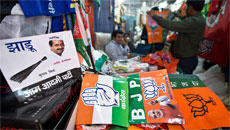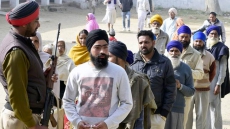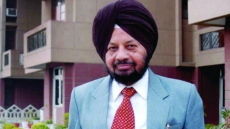Kuch na hona Punjab da, zameen banjar, aulad kanjar. (Nothing can come of Punjab -- lands barren, children jobless.)
That extreme assessment of India's 11th richest state was made by a drug kingpin in the dark film "Udta Punjab" (Flying Punjab). The statistical reality is that Punjab, home of the green revolution, has failed to grow its economy or prepare its young for the future. Employment and economic growth lag the national average.
The reality in Punjab, this reporter found, echoed the film and statistical assessment. The desire to leave their villages for better prospects elsewhere was common, and people expressed anger at the rise of drugs, the decline of jobs, and the failure of aspirations. The overriding demand: Change.
It was cold and overcast at noon, when the clouds parted to allow in weak sunlight and much-needed warmth. We were in the village of Heir, 4 km south of Amritsar airport, where departures to Tashkent, Doha, Dubai and Singapore reflect the flight of the Punjabi from his native land. Along the broken road to the main village square, a group of men, young and middle-aged, sat around talking.

What, we asked, were the crucial issues for the assembly election of February 4, 2017? They answered in unison: Unemployment. "Look at us," said Amrinder Singh, 34, science graduate and father of two. "It is the middle of the day, and all of us are sitting here whiling our time. There is nothing for us to do here."
After his graduation, Amrinder -- well built, smartly dressed in jeans and sneakers -- did find a job at a private company. Dissatisfied with the Rs 15,000 salary, he resigned. Amrinder wanted, as many young Punjabis do, a government job. He applied, unsuccessfully, to be a physical-education teacher and police sub-inspector. "To get selected, one must pay bribe, sometimes up to Rs 20 lakh," said Singh.
Singh's family does own farm land, but as families expand and farm sizes fall -- from 3.9 hectares to 3.7 hectares over five years from 2005-06 to 2010-11 -- farming isn't an option. Has he considered a business of his own? "Only those who have political backing can start a business," Singh claimed.
The end result is that Singh has been unemployed for eight years, waiting for that government job.
"It's not just me," he argued. "Most of the young men in the village suffer the same fate. That's why most of us are addicted to alcohol, tobacco or drugs. Three people from our village died of drug overdose in the last two-and-a-half months."

Punjab's drug problem has become a political issue, with good reason.
There are nearly 230,000 opioid dependent and 860,000 opioid users in Punjab, according to the 2015 Punjab Opioid Dependence Survey, conducted by researchers from the All India Institute of Medical Sciences and Society of Promotion of Youth and Masses, a non-profit working towards prevention of drug abuse.
The survey of 3,620 drug-dependent individuals found that 99 per cent of opioid dependents are male, 54 per cent are married, and 55 per cent are addicted to heroin, a synthetic opioid drug that causes feeling of euphoria and, at Rs 400 a gram, is one of the costliest drugs in the market. While 80 per cent of addicts tried to quit, no more than 35 per cent received professional help.
Opioid dependents spent Rs 1,400 per day on drugs -- or an estimated Rs 7,575 crore statewide every year.
"Drug addiction is more a symptom than a disease," said Ravinder Singh Sandhu, retired sociology professor from Guru Nanak Dev University, Amritsar. "Unfortunately, people still treat it as a personal and not a sociological problem."

Sandhu's 2009 sociological study of 600 drug addicts from urban and rural Punjab found that 73.5 per cent were aged between 16 and 35. Those who were illiterate (40.6 per cent) and with education up to fifth grade (22.3 per cent) were prone to drug addiction in rural areas, while those with a 10th-grade education (44.6 per cent), or more, were susceptible to drugs in urban areas. One in four respondents was unemployed.
"Drug addiction is directly linked with poverty and not with prosperity, as is the belief," said Sandhu. He implicated the quality of education in Punjab as a reason for the dissonance between what young people aspire to be and what they become.
For instance, while literacy and the general education budget rose over a year to 2016-17, spending on primary education and incentives to retain students in school were cut, leading to a doubling in the primary school dropout rate in one year.
Thousands of semi-educated youth over the years were left unprepared for a job market that has jobs only for the best or for the well-connected. This failure of aspiration adds to the stress that fuels drug use, said Sandhu.
Harinder (name changed) is 28, a post-graduate in English who could not find a job for four years. He and his friends first tried heroin, he said, because they were "bored". He was hooked to the drug and soon found he needed a fix first thing in the morning and last thing at night.

Harinder's family was well-off, and money was never a problem. He did think of quitting, but it did not work. "If you try to quit on your own, the whole system collapses, and the body aches," he told IndiaSpend at the 250-bed Swami Vivekanand Government Drug Deaddiction and Rehabilitation Centre (one of five such centres in Punjab), where he had checked himself in.
A psychiatrist (requesting anonymity since the election code of conduct was in force and he isn't authorised to speak to the media) treating drug addicts at the civil hospital of Tarn Taran, 25 km south of Amritsar city, said he saw up to eight new addicts and up to 30 follow-up cases every day: 80 per cent of the addiction is related to heroin.
"When I started in 2008, most cases were of pharmaceutical drugs, such as morphine, lomotil, tramadol, but now heroin is more common," he said, identifying the stigma involved as the greatest challenge in treatment. "Most people still see drug addiction as a moral failure," he said. "In fact, it's a chronic relapsing psychiatric illness with biological, social and psychological causes."
There are larger economic failures that drive the drug problem in the border districts, which are especially vulnerable to drugs and report higher rates of addiction than inland areas.

"If the border districts were offered better health, education and employment facilities, they would not be tempted to smuggle drugs," said J.S. Oberoi, a Deputy Inspector General with the Border Security Force, which guards the border with Pakistan. Many farmers with holdings between two and three acres, he said, work as drug-runners for as little as Rs 10,000 per run.
It is the pea-harvesting season and Kashmir Singh, 53, his family, and 30 other labourers are bending low to pick peas. We are in Amritsar's Pindiyan village, 50 km from the industrial town of Jalandhar and 40 km from the Pakistani border.
"Usually, we have less than five months of work every year," said Kashmir. During other months, he tries to get work as a casual worker in other villages or the nearby town. Since he earns less than Rs 60,000 a year and has no land, he is eligible for a government-issued "blue card", the other requirement for which, in rural areas, is that you have less than 2.5 acres of land -- it is also given to those with less than 100 sq. yards of land in urban areas.
But Kashmir hasn't got his blue card, more than a year after applying.

Blue card holders also get atta or wheat at Rs 2 per kg and dal or pulses at Rs 30 per kg. He hasn't heard of the 100 days of employment guaranteed by the 12-year-old Mahatma Gandhi National Rural Employment Guarantee (MGNREGA) Act. "We don't have any such card," he said.
The owner of the land Kashmir works is as unhappy as they are. Harbhajan Singh owns the two acres that he farms for wheat and peas. Over the last two months, he has lost Rs 35,000, as the rural economy temporarily collapsed after the demonetization of November 8, 2016.
"Peas are sold at less than Rs 10 per kg, which does not even cover the cost of fertilisers, seeds and labour," said Harbhajan. It is a good thing we don't depend only on farming, added Harbhajan, who was a soldier for 18 years and worked as a security guard at a bank for 24 years and earns pension from both. One son is in the army, and the other other looks after the farm.
The unemployment rate among the state's youth is 16.6 per cent while the Indian average is 10.2 per cent. Its rural youth joblessness rate in 2015-16 was 16.5 per cent; more than seven percentage points higher than rural India's 9.2 per cent.

Punjab's industries, services and overall economy grew 5.9 per cent in 2015-16, but that lagged the national average of 7.6 per cent. In 2016-17, with India's growth is likely to fall below 7 per cent, Punjab's growth will recede further.
As many as 18,770 factories closed between 2007 and 2014, when the SAD was in power, according to reports: 8,053 factories closed in Amritsar, and no new industries were started in Tarn Taran, Moga, Rupar and Mansa districts.
Back in Heir, we met former Sarpanch Balwinder Singh in front of his sprawling bungalow. Of the village's 2,500 adults, 350 have government-issued blue cards - meaning they have incomes less than Rs 60,000 per year and less than 2.5 acres of land -- and 300 earn government pensions.
"We have made all roads pucca, except one whose work is pending because of the election," said Balwinder. When we reached the main road of the village, his claims disintegrated, much like the road.
We asked Balwinder Singh about the drug problem, and he said: "When the parents can't control their own children, how can they expect the government to?"





